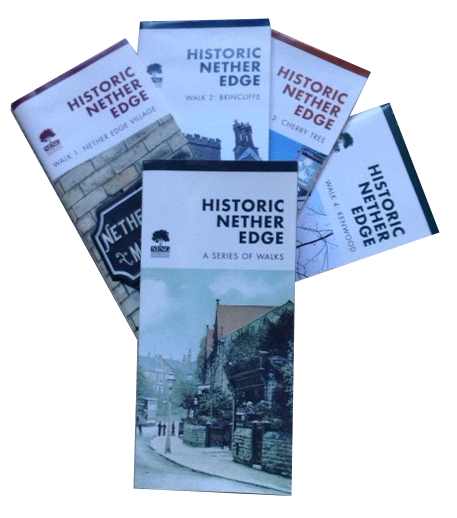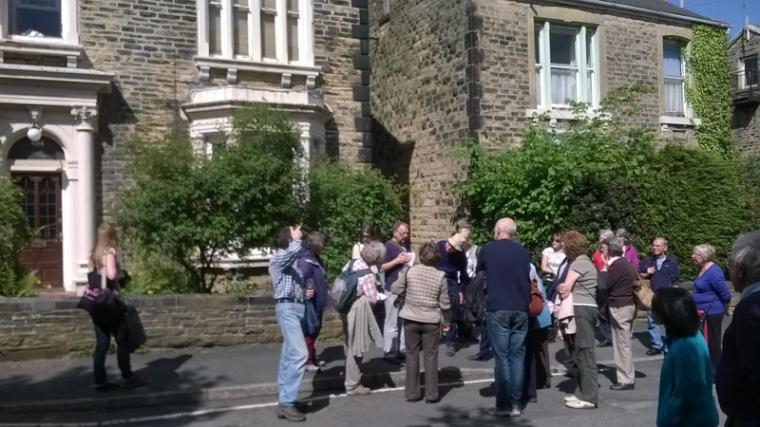
We are so lucky to live in Nether Edge with its open spaces and streets full of character, all with a different story to tell. The expansion of Sheffield from the mid 19th century transformed the farmland and hamlets lying below Brincliffe Edge and between the semi-industrialised Sheaf and Porter valleys into the classic Victorian and Edwardian residential suburb we have today. Much of the character and atmosphere of those times is still intact so Nether Edge has been designated a Conservation Area since 2002. However there has also been change. Our occupations and pastimes are different now and we form a much more diverse and lively community. Walking Nether Edge allows us to explore the evidence behind the evolution of our present neighbourhood.
For some time Nether Edge History has been leading guided walks and we hope to resume them once Covid has been put under control. Information will be on this website, in Edge magazine and elsewhere. In the meantime, we have for sale at £4 a pack of four different walks that you can follow yourselves to appreciate our local history. Each of the four walks has small maps of past Nether Edge and a larger localised map with its route of numbered features. Each walk has accompanying illustrated text. They are very easy to follow as one walks around.
Walk 1: Nether Edge Village covers the heart of Nether Edge. It looks at its shops, transport and architecture. It also looks at how the area developed; its farming roots and building history go back as far back as 400 years ago. Who would have thought it once housed a slaughterhouse and the first electric tram? Now it is the hub of Nether Edge, with places to eat, drink and meet friends. It is famed for its quarterly farmers’ markets of locally produced food and goods.
Walk 2: Brincliffe explores an area that is almost entirely residential but which preserves fragments of its industrial past. Dominating the area is the Victorian Ecclesall Bierlow Workhouse built in response to the New Poor Law of 1834. This demanded that the poor and destitute be housed in one central large workhouse instead of being supported in their own homes or very small local workhouses. It became a hospital in 1929; many babies from Nether Edge and beyond were born there. Now it is a development of private apartments and houses, but care has been taken to retain much of its original character. The NHS still uses some of the site for its specialised units.
One passes an old sewer gas lamp, the peaceful Brincliffe Woods, the quarries from which came the stone to build many of the original houses, the former Grammar School and Bluecoat School and some of the largest and oldest houses in Nether Edge all with fascinating stories behind them.
Walk 3: Cherry Tree explores the area formerly known as Cherry Tree Hill and Common. Its inhabitants used to be farmers, combining farming with small scale industrial enterprises. The 19th century saw the new wealthy manufacturers moving in with their grandiose houses.
The walk takes you past the Union Hotel pub, built to serve the needs of those working on the new Union workhouse, a modern theatre and lots more besides. Amongst other features there are; the two oldest houses one built in 1605 and the other in 1765; Shirley House, the grand home of William Tyzac the cutlery manufacturer; Prior Bank, once the home of John Cole founder of what is now John Lewis department store; and the tiny cottage on Edge Bank where its builder Charles Boot lived with his wife Sarah and eight children.
Walk 4:Kenwood explores the attractive streets of Kenwood and the influence of the cutlery manufacturer George Wostenholm (1800-76) who built nearby Kenwood Hall and began the development of this previously agricultural area in the 1850s. It is said that his wife had a say in the tight restrictions given to the local builders as she did not want to be looking out on to little plain homes of the ‘hoi polloi’. Hence there are the tree-lined streets with their middle class houses renowned for their decorative features.
The walk takes you past the amenities that grew to service the growing population such as the little Lantern Theatre, but also points out the features that existed way before Wostenholm’s time.
To buy a set of walks for £4 contact nenghistory@gmail.com

